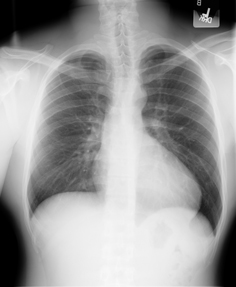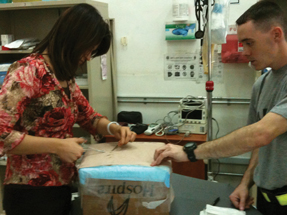MKSAP Quiz: Cause of hypertension
An asymptomatic 25-year-old man is evaluated for hypertension diagnosed during a recent pre-employment physical examination. He does not remember being told about hypertension in the past, and he has no family history of hypertension. He is not taking any medications.
On physical examination, his blood pressure is 170/60 mm Hg in both upper extremities. The heart rate is 65/min and regular. Carotid examination is normal; estimated central venous pressure is not elevated. The apical impulse is displaced and sustained. An ejection click is noted at the apex and left sternal border. There is a grade 2/6 early systolic murmur noted at the second right intercostal space. No diastolic murmur is noted over the anterior precordium. Systolic and diastolic murmurs are noted over the patient's back. There is no bruit noted over the abdomen. The lower extremity pulses are reduced and delayed.
A chest radiograph is shown.

Which of the following is the most likely diagnosis in this patient?
A. Coarctation of the aorta
B. Essential hypertension
C. Pheochromocytoma
D. Renal artery stenosis
Answer and Critique
The correct answer is A: Coarctation of the aorta. This question can be found in MKSAP 15 in the Cardiovascular Medicine section, item 87.
This patient has classic features of aortic coarctation. He has a pulse delay between the upper and lower extremities (radial artery to femoral artery delay). The blood pressure in the lower extremities, when measured, will be lower than the blood pressure noted in the upper extremities. The patient also has an ejection click and an early systolic murmur consistent with a bicuspid aortic valve, which is present in more than 50% of patients with aortic coarctation. The systolic and diastolic murmurs noted over the back are related to collateral vessels, which also cause the sign of rib notching, seen on this patient's chest radiograph on the inferior surface of the posterior upper thoracic ribs bilaterally.
Essential hypertension is a common cause of systemic hypertension, but the physical examination features of this patient are not explained by this diagnosis. In addition, a family history of hypertension is common in patients with essential hypertension.
Pheochromocytoma causes paroxysmal hypertension in about half of affected patients; other pheochromocytomas present similar to patients with essential hypertension. The signs and symptoms of pheochromocytoma are variable. The classic triad of sudden severe headaches, diaphoresis, and palpitations carries a high degree of specificity (94%) and sensitivity (91%) for pheochromocytoma in hypertensive patients. The absence of all three symptoms reliably excludes the condition. Finally, the physical examination features in this patient do not reflect this diagnosis.
Renovascular hypertension due to fibromuscular disease of the renal arteries usually presents in patients younger than 35 years of age. Atherosclerotic renovascular disease is more common in older patients and is frequently associated with vascular disease in other vessels (carotid or coronary arteries and peripheral vessels). Azotemia is often observed in patients with atherosclerotic renovascular hypertension. Renal artery stenosis cannot explain this patient's cardiac and peripheral vascular examination findings.
Key Point
- Coarctation of the aorta should be suspected in a young patient presenting with systemic hypertension.





